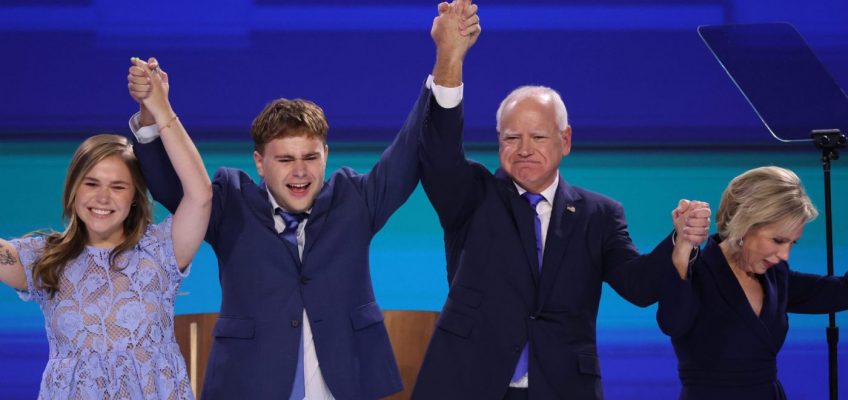By DAVID BAUDER AP Media Writer
The Democratic convention presents Fox News Channel with a delicate challenge: how to cover a party suddenly enthused about its election chances when much of the network’s audience has a different political viewpoint.
During the Democrats’ first two days, Fox personalities called the proceedings “boring” and filled with “a lot of hate.” There was a focus on demonstrations outside the arena while many of the speakers inside went unheard on the air. Presidential nominee Kamala Harris was given nicknames like “the princess” and “comrade Kamala.”
“We’re at the DNC,” Sean Hannity quipped, “so you don’t have to be.”
Fox’s telecast illustrated the challenges inherent in covering news events on networks that are filled with both breaking news and partisan political talk, sometimes mashed up — where opinion personalities like Hannity, MSNBC’s Rachel Maddow and CNN’s Van Jones freely mix with reporters and blur boundaries. During the GOP convention last month, the liberal-leaning MSNBC cut off Nikki Haley in favor of a discussion about how she debased herself, and ignored Ron DeSantis entirely.
The feel-good Republican gathering gave Fox News the biggest convention audience ever for a cable network, a feat at a time when millions of Americans are pulling the plug on subscriptions, and a staggering audience of 10.4 million people for the opening moments of former President Donald Trump’s acceptance speech, the Nielsen company said.
No one expects such numbers this week for Fox, where roughly two-thirds of the audience in a 2024 Nielsen/MRI study called themselves Republican. Fox’s audience has shown a marked tendency to tune away from news that doesn’t reflect its beliefs, such as the Jan. 6 committee hearings.
Fox had 2.5 million viewers for Monday’s DNC coverage, 1.7 million on Tuesday — the latter sixth among networks covering it. Fox was the most-watched network for both of the first two nights of the GOP session a month ago, with 6.9 million on opening night and 5.4 million on the second night.
Not mincing words
Hosts on “The Five,” Fox’s most-watched show, were nothing if not direct in setting the stage for the Democrats’ week. “You can’t believe anything the Democrats tell you,” Jesse Watters said. “Everything is a lie. … There is no joy here. The only joy is that Joe’s gone.”
Watters said “no one believes” that the economy is good, or that polls showing Harris rapidly making up ground against Trump since replacing Biden at the top of the ticket are real. Later Monday evening, Watters declared the event boring, saying “this is like a convention your boss makes you go to.” Hannity described the convention as “far-left radical protesters outside and manufactured unity, deception and lying inside.”
Fox hosts uniformly rejected the Democrats’ interpretation that Biden had committed a selfless act by giving up his reelection bid and called the president’s appearance on Monday more humiliating than valedictory. “You had to wrestle this job away from him like it was car keys from a drunk,” said Greg Gutfeld, who called former President Barack Obama the “Barack-stabber.”
Harris was depicted as an inexperienced, risky choice. Onscreen messages, or chyrons, during Laura Ingraham’s show drove home the point: “Dems Overconfident in Their Unproven Backup,” read one. Others: “Kamala’s All Vibe, No Substance” and “Comrade Kamala Fails Econ 101.”
“This is like booking tickets on the Titanic,” analyst Keith Kellogg said.
During most of Hannity’s show on Tuesday, an onscreen camera was focused on a nonviolent protest outside of the convention. “The convention has been full of a lot of hate,” Hannity said, “instead of the politics of joy, which you’ve been promised.”
Who made it and who didn’t
Fox News has made room for Democrats willing to come on its shows this week for interviews, including Harris campaign co-chair Cedric Richmond, Transportation Secretary Pete Buttigieg, U.S. Rep. Debbie Dingel and U.S. Sen. Mark Kelly. Fox said it has seen a 40% increase in bookings of Democrats compared with last year, and that its sister business network presents full coverage of convention speeches.
Fox says it has the same footprint on the ground for the DNC in Chicago as it did for the Republican convention in Chicago last month. It rejects the notion that it is unwilling to show the Democrats’ point of view.
Related Articles
DNC in Chicago: What happened Wednesday — and what’s coming Thursday
Democrats conclude their convention Thursday with their new standard bearer, Kamala Harris
‘That’s my dad!’: Gus Walz tearfully cheers on his father as he accepts Democratic VP nomination
Walz’s night, Bill Clinton’s dig at Trump, influencers flexing clout. DNC Day 3 takeaways
RFK Jr. to speak Friday, fueling speculation he could drop out and support Trump
Fox carried Biden’s speech in its entirety Monday night, as well as some other moments including Harris’ short, surprise address, which occurred during Hannity’s show. Both Barack and Michelle Obama were carried on Tuesday night. Speeches by Hillary Clinton and Alexandria Ocasio-Cortez — both deeply unpopular with many in Fox’s audience — were also carried in full. Fox’s Dana Perino said Ocasio-Cortez made a great speech, “but it didn’t make any sense.”
Fox anchor Bret Baier praised both Obamas, saying the former first lady “had an amazing speech that got this crowd on their feet.” Lawrence Jones, “Fox & Friends” co-host, said Wednesday that “no matter how inspirational they are, no matter how good the cadence is on the stage, you can’t dip BS in gold and expect the American people to buy it.”
Several podium appearances covered elsewhere went unheard on Fox News Channel: Olympics basketball coach Steve Kerr, UAW President Shawn Fain, the Rev. Jesse Jackson, U.S. Rep. Jim Clyburn, U.S. Rep. Jamie Raskin and U.S. Sen. Tammy Duckworth. Fox analyst Brit Hume complained that a group of women who talked about abortion policy did Biden a disservice by going on too long — even though the network did not follow their remarks.
Tim Graham, director of media analysis for the conservative Media Research Center, said Fox programs to its audience in much the same way that Nicolle Wallace and Rachel Maddow say they won’t show Trump because of concerns that he’ll lie, “but it’s because they don’t want to watch it.”
Brian Stelter, author of “Network of Lies: The Epic Saga of Fox News, Donald Trump and the Battle for American Democracy,” said that while Fox News Channel recognized the news importance of the convention, he saw it as reluctant to give its viewers an unvarnished view of what was being said.
“Fox did very little listening and a lot of talking,” he said.
Interestingly, there was an effort by the campaigns Monday to reach beyond friendly territory: The Harris campaign ran a commercial on Fox, while Trump advertised on CNN.
Fox has been particularly sensitive about not threatening audience loyalty. Concerns about its audience’s anger with Fox following coverage of the 2020 presidential election were cited in evidence presented by Dominion Voting Systems in its defamation suit against Fox. That suit was settled when Fox agreed to pay $787 million.




